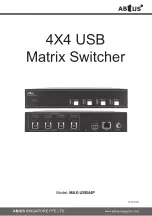
Introduction
Congratulations on your purchase of this Fast Ethernet Dual-Speed Hub!!
The Fast Ethernet Dual-Speed Hub consists of 8XRJ-45 ports for 10Mbps or
100Mbps Ethernet connection (determined by autosensing). This Dual-Speed hub
contains two internal repeaters - one for 10Mbps and another for 100Mbps traffic.
An internal Ethernet switch, consisting of a 10Mbps and a 100Mbps switching port,
is used to link the repeater buses. Data will be forwarded to the other internal
repeater bus under these three conditions: 1) when traffic has to be passed
between a 10Mbps and a 100Mbps device; 2) if the destination address is not
found in the address table; 3) when broadcast traffic is sent.
This hub is capable of storing the node address and the corresponding seg-
ment of each incoming packet in a routing table. The information on this routing
table helps to identify the traffic and directs fast (100BASE-TX) or slow (10BASE-
traffic to the proper repeater buses. By separating the two repeater buses into dif-
ferent collision domains, the overall collisions that might occur are reduced relative
to the number that might occur if two traffic flows were to coexist in a singular colli-
sion domain.
Migration from 10Mbps Ethernet to 100Mbps Fast Ethernet environment usually
involves total abandonment of 10Mbps equipment and requires replacing upgrad-
ing to 100Mbps equipment. In contrast, Dual-Speed Hubs allow gradual migration
from one speed to another without throwing out 10Mbps network hardware.
This manual will introduce you to the main features of your hub, as well offer as
a brief introduction on networking terminology and topography. Tips for installation
and for everyday management of your network (including troubleshooting) are also
included to help you get started.
II




































